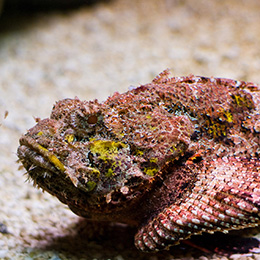Poisonous Reef Fishes
 The Stonefish is Poisonous Enough to Kill a Person
The Stonefish is Poisonous Enough to Kill a PersonReef fishes face the same predation pressures as invertebrates, so it is perhaps not surprising that some of them, too, defend themselves with toxins. However, fish have fewer methods of deploying their poisons. In most cases, they inflict them using their fin rays, and for good reason: spiny fin rays are excellent for piercing the skin of a predator's mouth (or an unwary hand), while glands at the base of the fin and grooves in the ray itself shoot a dose of toxin rapidly into their attacker. For the poison to be useful to the fish, it must be fast acting, otherwise by the time it has had any effect on a predator, it will be too late for the victim.
What makes a reef fish likely to be poisonous?
Coral reef species have a range of defenses against predation, but for those species whose lifestyles put them in the line of fire, toxins can be invaluable. Slow, small, and solitary fishes are most at risk from predators, and pufferfish and their relatives are all of these. Their unusual method of swimming means they cannot out-swim a predator; most species are small and the distribution of their food means they are often solitary, so they become sitting targets — little wonder they are so deadly poisonous.
But puffers are not the only poisonous fish on the reef; species as diverse as the Plotosus catfish, the foxface, and blue-lined surgeonfish incorporate poison into their defenses through venomous spiny fin rays. Lionfish bristle with poisonous fin rays and would make a thoroughly unpleasant mouthful for any predator naive enough to attack them. Small, coral-dwelling gobies of the Gobiodon genus, which would otherwise be prey for many hunters, produce toxic skin secretions. Most predators avoid them, even steering clear of pieces of harmless food that have been experimentally wiped with the mucus of these fish.
How toxic can coral reef fish get?
Fish can be toxic in two ways, either adopting a form of chemical defense against their predators as discussed above, or as a by-product of their diet. Pufferfish and their relatives have some of the most effective chemical defenses known among all fish. Their bodies are laced with an extremely powerful nerve toxin known as tetrodotoxin, which is over 1,000 times more potent than cyanide. Some species are more poisonous than others, but the most toxic of these produce enough poison to kill 30 people.
Lionfish, scorpionfish, and stonefish use chemical defenses too, but of these only the stonefish is likely to be fatal to humans. At the top of the marine food chain are many predatory fish that are poisonous for humans — and potentially other mammals — to eat. The reason for this is ciguatera poisoning. Marine dinoflagellates produce this toxin, which is passed up the food chain. The dinoflagellates are eaten by the herbivores, which
in turn are eaten by predators. At each successive step in the food chain, the ciguatera toxin becomes concentrated in the tissues of the fish. In top predators, such as barracuda, the levels of ciguatera in the animal's flesh are so great that humans can become seriously ill if they eat it



Leave a Reply